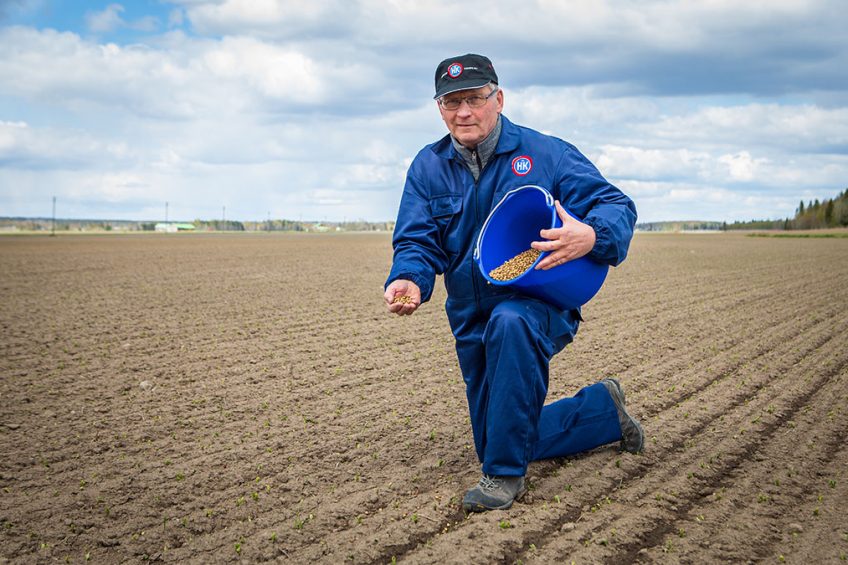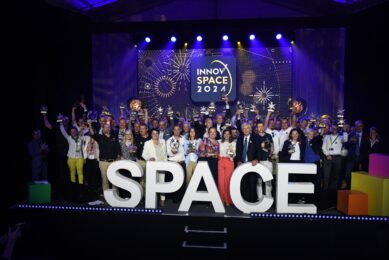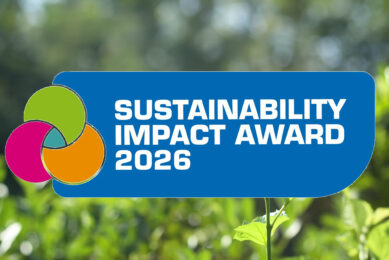Finnish pigs receive feed from the farm

The EU PiG Innovation Group aims to raise the competitiveness of the European pig industry by connecting producers and sharing tried and tested best practices. In this edition: the pigs in Finland’s Rapeseed Pork programme.
The Ambassador
Matti Ropilo, owner of MTY Alakukku farm in Vampula, Finland. The farm has a production agreement with the company HKScan, to which the Rypsiporsas pork brand belongs. The farm buys piglets from HKScan and then, after the finishing period, pigs are sold back to the company for slaughter.
The innovation
Rypsiporsas is Finnish for ‘Rapeseed Pork’. Winning in the category ‘Precision production’, Rypsiporsas pigs are raised free of antibiotics and are fed homemade feed. Pig Progress asked Matti Ropilo, owner of MTY Alakukku farm, to explain more about his farm. “We produce meat almost totally with our own grains that we harvest from our own fields near the farm,” he said. “Our farm prevents environmental load to the water system with 4 hectares of buffer strips on riversides. We also have a wetland system with 3 dams, and we have increased own energy production with wood chip burning and solar panels.”
The idea
Ropilo says that replacing imported soy with Finnish feed components results in tastier meat rich in omega-3 fatty acids. These feed components are broad bean, crushed turnip rape, rapeseed oil and OVR, which is an abbreviation for a barley protein feed that is a factory by-product. With this feed the meat quality and fat composition change, and sustainability is heightened.
Advantages
Ropilo believes that the greatest advantage as a producer is knowing that the pigs are sold without any interference in the market, and being able to get new growers as soon as he has sold the previous group so the flow of pigs is not disturbed. Further notable benefits:
- A 24% reduction in carbon footprint, i.e. 2.5kg CO2/kg live weight compared to an average of 3.3kg CO2/kg live weight in other HKScan Rypsiporsas producers.
- A 35% reduction in purchased protein, saving about € 20,000 per year.
- Feeding days have remained consistent: 96–97 from 2017 to 2020.
- Products such as Rypsiporsas pork have a better price and less fluctuating demand.
- Healthier pigs.
The costs
A € 15,000 investment was made on 2 new storage tanks when the farm started with Rypsiporsas production – one for oatmeal-based protein feed and the other for rapeseed oil. Furthermore, € 18,000 was spent on the installation of solar panels for a 16 kilowatt system. The return on investment for this is 11 years.
Variable production costs decreased by 7.4% per kg of meat, mainly due to lower energy costs (down 17%), feeding costs (down 8.8%) and veterinarian and medical costs (down 7%). An increase was observed, however, with fixed costs at 3.6% per kg as a result of investments. Overall, the total cost of meat production was 5.1% less per kg of meat.
What’s next?
The next goal is to make production carbon neutral. Foodstuffs make up the biggest share of the farm’s footprint, so Ropilo is participating in a project to optimise the input/output ratio of feed. The project studies conservation agriculture in terms of fertilisation and soil cultivation methods.
“I am waiting to get more profound methods for counting the carbon footprint, so that calculations are based on the exact production methods of each farm. Now, the emissions for the commercial feed are average Finnish values,” says Ropilo. “To get a precise carbon footprint for each farm, we need to know the information about each field, its size, shape and distance from the farm centre. This would help farmers to plan their future investments and innovations to decrease their carbon footprint.”
EU PiG Innovation Group
 The EU PiG Innovation Group (EU PiG) aims to help pig producers find tried-and-tested best practice from fellow producers across Europe. Through an annual EU-wide contest, called the EU PiG Grand Prix, more than 300 producers share their innovative ideas and best practices, which are developed in response to industry-wide challenges, to compete to become one of eight EU PiG ambassadors. Each year, two topics are chosen for each of the project’s four key themes, namely health management, meat quality, animal welfare and precision production. In this and the next editions of Pig Progress, one best practice will be discussed.
The EU PiG Innovation Group (EU PiG) aims to help pig producers find tried-and-tested best practice from fellow producers across Europe. Through an annual EU-wide contest, called the EU PiG Grand Prix, more than 300 producers share their innovative ideas and best practices, which are developed in response to industry-wide challenges, to compete to become one of eight EU PiG ambassadors. Each year, two topics are chosen for each of the project’s four key themes, namely health management, meat quality, animal welfare and precision production. In this and the next editions of Pig Progress, one best practice will be discussed.











